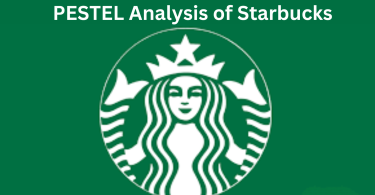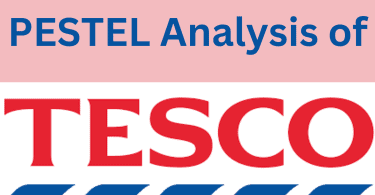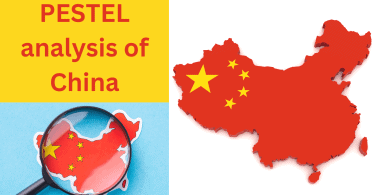Tesla Pestel analysis overview
Tesla Inc. is a leading American electric vehicle and clean energy company disrupting the automotive industry for over a decade.
Despite stiff competition from established automakers, Tesla’s innovative products and services have helped it maintain its position as a market leader.
However, Tesla’s success is not solely determined by its internal operations but is also impacted by external factors in the macro environment.
Our team has recently conducted a PESTEL analysis to examine the impact of the macro-environment factors on Tesla’s growth.
The following is a detailed article on Tesla’s PESTEL analysis. It discusses the political, economic, sociocultural, technological, environmental, and legal factors influencing its performance and profitability in the coming years.
Political Factors
Political factors refer to the impact of government policies and regulations on businesses. Political factors, including tariffs, taxes, trade policies, and government subsidies, can impact Tesla’s operations.
Here are some critical points on the influences of the international political environment on Tesla’s corporate performance with concrete examples:
Trade Policies
Tariffs imposed by governments can increase the cost of producing Tesla vehicles and lead to higher prices for consumers. For example, in 2018, China raised tariffs on imported cars from the US, including Tesla, by 40%.
Also, changes in trade agreements or restrictions on certain types of imports could limit Tesla’s ability to source critical components required in its manufacturing process. For instance, restrictions on the import of lithium-ion batteries or rare earth metals could impact Tesla’s production.
Government Regulations
Stricter environmental regulations can increase demand for EVs like Tesla’s, but relaxed rules or delayed implementation could slow Tesla’s growth and profitability. For example, the Trump administration weakened Obama-era fuel efficiency standards, which could impact Tesla’s sales in the US market.
Inconsistent regulations across different countries could also be a challenge for Tesla. For instance, Europe has more stringent emissions standards than other regions, and Tesla may have to adjust its products to comply with these regulations.
Political Instability
Countries experiencing political unrest or conflict may face economic downturns, leading to decreased demand for luxury goods such as EVs. For example, during the Arab Spring and the war in Ukraine, sales of luxury cars in Egypt and Russia dropped significantly.
Political instability can also challenge Tesla when establishing or maintaining operations in affected areas. For instance, in 2020, Tesla faced difficulties opening a factory in Germany due to protests and legal challenges.
Incentives and Subsidies
Government incentives and subsidies can make EVs more affordable and increase demand for Tesla’s products. For instance, in the US, there is a federal tax credit of up to $7,500 for buyers of electric vehicles.
Government policies aimed at reducing carbon emissions have also played a significant role in Tesla’s success. For example, countries like Norway and China offer incentives to consumers who purchase EVs, which has helped increase demand and boost Tesla’s sales in these regions.
However, changes to these incentives and subsidies could impact Tesla’s sales. For example, EV sales dropped significantly in Hong Kong after the government reduced a tax break for EVs.
Geopolitical Tensions
Sanctions or other economic measures taken against certain countries could limit Tesla’s ability to do business in those regions, resulting in lost sales and revenue. For example, in 2019, Tesla was forced to reduce staff at its Shanghai factory due to US-China trade tensions.
Currency fluctuations resulting from geopolitical tensions can also impact Tesla’s profitability. For instance, during the Brexit negotiations, the value of the British pound decreased, which impacted Tesla’s sales in the UK market.
Overall, the international political environment can significantly impact Tesla’s corporate performance. By staying aware of these potential influences and adapting to changing political environments, Tesla can continue to navigate challenges and achieve long-term success.
Economic Factors
Economic factors refer to the impact of economic conditions on businesses. Economic factors can impact Tesla’s sales, profitability, and growth.
Inflation is among the most significant economic factors affecting Tesla’s performance and profitability. High inflation rates can lead to higher production costs for Tesla, resulting in higher vehicle prices.
Tesla also faces inflationary pressures from the rising cost of raw materials such as steel and copper. For example, in May 2021, Tesla increased the price of its Model 3 and Model Y vehicles due to supply chain challenges and inflationary pressure on raw materials.
This increase was a direct consequence of high inflation rates, leading to higher production costs for Tesla.
Unemployment is another factor that can impact Tesla’s sales volume.
High unemployment rates can affect consumer spending, decreasing demand for luxury items like electric vehicles, including those produced by Tesla.
During the COVID-19 pandemic, many people lost their jobs, significantly decreasing demand for luxury items, including electric vehicles. In Q2 2020, Tesla’s revenue decreased by 5% due to lower vehicle demand caused by high unemployment rates.
However, as the economy recovers, unemployment rates are expected to decrease, and consumer confidence and purchasing power are likely to increase, which could positively impact Tesla’s performance and growth.
Interest rates are another crucial factor impacting Tesla’s performance. Higher interest rates can make it more expensive for consumers to finance or lease Tesla vehicles, reducing demand and sales volumes.
High-interest rates can also increase Tesla’s cost of borrowing, making it more challenging for them to fund growth initiatives and investments.
Conversely, lower interest rates can stimulate demand for electric vehicles and reduce Tesla’s financing costs, supporting growth and expansion. In 2018, when interest rates increased, Tesla’s lease applications decreased by 24%, affecting their sales volumes.
Exchange rates are also an important economic factor affecting Tesla’s financial performance. Tesla generates a significant portion of its revenue outside of the US, making it vulnerable to fluctuations in exchange rates.
Stronger foreign currencies relative to the US dollar can increase Tesla’s revenue when converted to USD, while weaker currencies can have the opposite effect.
In Q1 2021, Tesla reported a $101 million negative impact from foreign currency exchange rates due to the appreciation of the US dollar.
The COVID-19 pandemic significantly impacted the global economy, affecting Tesla’s sales volume and revenue. During the first half of 2020, Tesla faced production shutdowns and supply chain disruptions due to the COVID-19 pandemic, leading to decreased vehicle deliveries and revenue.
The global economic crisis caused by COVID-19 led to a significant decrease in demand for luxury items, including electric vehicles. However, as the economy recovers, Tesla will benefit from increased demand for electric vehicles and sustainable energy products.
Rising raw materials prices are another factor that can significantly impact Tesla’s production costs and profit margins. Tesla relies heavily on raw materials such as lithium, cobalt, nickel, and copper for its battery production.
Commodity fluctuation can significantly impact Tesla’s production costs and profit margins. For example, in Q4 2020, Tesla’s gross margin decreased by 3.7 percentage points due to higher raw material costs, primarily related to nickel and cobalt.
In conclusion, various economic factors can significantly impact Tesla’s growth. Inflation, unemployment, interest rates, exchange rates, the global economic crisis after COVID-19, and rising raw materials prices are some of the most critical factors to consider.
While some factors can pose challenges, others can provide huge opportunities for Tesla to grow and expand. As the global economy recovers from the pandemic, it will be interesting to see how these economic factors shape Tesla’s future.
Social Factors
The performance of Tesla has been significantly impacted by social and cultural factors, including:
Consumer Demand
The worldwide increasing awareness of climate change and the need for sustainable transportation has increased the demand for electric vehicles (EVs).
As a result, the sales of Tesla have skyrocketed in recent years, with the company selling over 499,550 EVs in 2020 alone.
Brand Image
Tesla’s image as an environmentally friendly and cutting-edge company has helped attract diverse consumers, from tech enthusiasts to eco-conscious individuals.
This has allowed Tesla to enter new markets and establish itself as a leader in the EV industry.
Infrastructure
The availability of charging stations and other EV-related infrastructure has also impacted Tesla’s performance in areas with few charging stations. EV adoption rates tend to be lower, limiting Tesla’s market potential.
Culture
Tesla’s success can also be attributed to its innovative and forward-thinking culture. The company has attracted talented engineers, designers, and executives passionate about developing new technologies that can help mitigate climate change.
Elon Musk
Finally, Tesla’s founder and CEO, Elon Musk, has played a critical role in the company’s success. His vision and leadership have helped Tesla navigate through challenging times, such as production delays and financial difficulties.
Technological Factors
Technological factors refer to the impact of technological advancements on businesses. Technological factors can impact Tesla’s innovation, product development, and competitive advantage.
Tesla has been at the forefront of technological advancements in the automotive industry, particularly in developing electric vehicles and autonomous driving technology.
However, other companies are investing heavily in developing EVs and autonomous driving technology, which can threaten Tesla’s competitive advantage.
Here’s a detailed points on the impact of technological factors on Tesla’s performance and growth:
Innovative Battery Technology
One of the most significant technological factors that have impacted Tesla’s performance and growth is its innovative battery technology.
The company invested heavily in developing and refining its batteries, resulting in longer-lasting, more efficient, and cost-effective electric cars.
For example, Tesla’s Model S uses lithium-ion batteries that are lighter and more energy-dense than those used by competitors, giving it a range of up to 402 miles per charge.
This technological advantage has helped Tesla gain a strong foothold in the electric vehicle (EV) market.
Autonomous Driving Technology
Tesla’s Autopilot system is another significant technological factor contributing to its growth. The system uses cameras, radar, and ultrasonic sensors to detect traffic and obstacles, enabling the car to steer, accelerate, and brake automatically.
Tesla’s advanced driver-assistance technology has impressed customers and industry experts alike, giving Tesla a competitive edge over other EV makers. Tesla’s Full Self-Driving (FSD) package also promises even more advanced capabilities, including automatic navigation, parking, and summoning.
Manufacturing Efficiency
Tesla has also leveraged technological advancements to optimize its manufacturing processes, further boosting its growth.
For example, the company’s Gigafactory, a sprawling facility for producing batteries and assembling vehicles, features state-of-the-art automation, robotics, and data analytics.
This has resulted in higher production volumes, lower costs, and improved quality control. Tesla’s focus on manufacturing efficiency has allowed it to scale quickly and meet the growing demand for its products.
Energy Storage Solutions
Besides its EVs, Tesla has expanded into the energy storage market with products like the Powerwall and Megapack. These solutions utilize advanced battery technology to store solar energy generated during the day for use at night or during power outages.
Tesla’s energy storage systems have helped accelerate the adoption of renewable energy by making it more reliable and accessible. Additionally, Tesla’s acquisition of SolarCity in 2016 has enabled the company to offer fully integrated solar and energy storage solutions to homeowners and businesses.
Software Updates
Tesla’s ability to continually update its vehicles’ software through over-the-air updates is a technological factor that has contributed significantly to its growth.
These updates provide new features, improved performance, and bug fixes without requiring customers to bring their cars into a dealership. This has led to high customer satisfaction ratings and loyalty, increased referrals, and word-of-mouth marketing.
Environmental Factors
Environmental factors refer to the impact of the natural environment on businesses. As a clean energy company, Tesla’s operations are heavily impacted by environmental factors.
This section examines the impact of these factors and environmental disasters on Tesla’s performance and growth.
Increased awareness and concern for environmental issues have increased demand for eco-friendly products, including electric vehicles.
Tesla’s commitment to producing sustainable transportation has positioned the company as a leader in this industry, attracting environmentally conscious consumers.
For instance, in 2020, Tesla’s global sales of electric vehicles accounted for 16% of the market share. This can be attributed to the company’s efforts to produce electric vehicles that reduce greenhouse gas emissions and contribute to a cleaner environment.
Tesla’s focus on reducing its carbon footprint is another important environmental factor contributing to its growth. The company’s mission statement includes reducing global carbon emissions through clean technology.
Tesla has developed innovative technologies such as solar panels, energy storage systems, and electric vehicles that minimize carbon emissions.
For example, Tesla’s Powerwall, a home energy storage system, enables homeowners to store excess solar energy and use it during peak demand, reducing reliance on traditional power grids.
Promoting renewable energy sources also significantly contributes to Tesla’s growth. The company has invested heavily in developing renewable energy solutions, enabling it to diversify its product portfolio beyond electric vehicles.
Tesla’s acquisition of SolarCity, a leading solar panel manufacturer, has enabled it to expand into the market. This has created new revenue streams for the company while promoting renewable energy sources.
Dependence on raw materials is a challenge faced by many industries, including the automotive sector. Tesla’s focus on sustainability has led the company to explore alternative sources of raw materials for its products.
The company has invested in developing more sustainable battery technologies that reduce dependence on rare earth minerals.
For example, Tesla’s new battery technology relies on a lower percentage of cobalt, a mineral often sourced from conflict zones.
Finally, environmental disasters or events such as natural disasters can impact a company’s performance and growth.
For instance, in 2018, Tesla’s production was disrupted by a series of natural disasters, including wildfires and hurricanes.
However, the company’s investment in renewable energy solutions enabled the company to recover quickly from these disruptions. Tesla’s solar panels and energy storage systems were critical in providing power to affected communities.
Legal Factors
Legal factors refer to the impact of laws, regulations, and legal requirements on businesses. These factors can significantly impact a company’s operations, product development, and market position.
This is particularly relevant in the case of Tesla, one of the world’s most innovative and disruptive car manufacturers.
Tesla has always been at the forefront of innovation, developing cutting-edge, sustainable, environmentally friendly electric vehicles (EVs).
However, as a global company, Tesla must comply with various legal requirements and regulations across different markets. Failure to do so can seriously affect its operations, reputation, and financial performance.
One of the key legal factors affecting Tesla is the increasing focus on emissions standards and safety requirements worldwide.
Governments are becoming increasingly concerned about the environmental impact of cars and are introducing stricter emissions standards to combat climate change.
This is particularly relevant in Europe, where new emissions standards are being introduced, making it more difficult for car manufacturers to sell their products in certain markets. This could impact Tesla’s ability to sell its EVs in Europe if they fail to meet these new standards.
Similarly, safety requirements are becoming increasingly important for car manufacturers. Governments worldwide are introducing new safety regulations, such as mandatory airbags, anti-lock brakes, and electronic stability control systems.
Failure to comply with these regulations can result in fines, legal action, and damage to a company’s reputation.
Legal disputes also pose a risk to Tesla’s operations and reputation. Patent infringement lawsuits, for example, have become increasingly common in the tech industry, including the automotive sector.
Tesla has been involved in several high-profile patent infringement cases, which have impacted its reputation and financial performance.
For instance, in 2019, Tesla sued a former employee for allegedly stealing trade secrets related to its Autopilot technology.
The lawsuit resulted in a settlement agreement between Tesla and the former employee, but it highlighted the risks associated with intellectual property theft and legal disputes.
As Tesla expands its business worldwide, it must navigate a complex legal landscape to ensure compliance and mitigate potential risks.
Tesla Pestel Analysis Summary
To summarize the results of the TESLA Pestel analysis, we present the significant opportunities and threats related to Tesla’s macro environment.
| Component | Opportunities | Threats |
| Political | 1. Government incentives for electric vehicles can increase demand for Tesla’s products;
2. Favorable policies promoting renewable energy can improve Tesla’s brand image and increase public support; 3. Reduced regulations on autonomous driving technology can lead to faster development and implementation. | 1. Changes in trade or tariff policies could increase manufacturing and production costs;
2. Political instability or conflicts in countries where Tesla operates can disrupt supply chains and sales; 3. Changes in government regulations related to emissions standards or safety requirements can impact Tesla’s operations and profitability. |
| Economic | 1. Growing demand for electric vehicles in emerging markets can expand Tesla’s customer base;
2. Expansion into new markets and product lines can provide additional revenue streams; 3. Shift towards sustainable and environmentally-friendly business practices can improve Tesla’s brand reputation and attract socially conscious investors. | 1. Fluctuations in exchange rates or interest rates can impact Tesla’s financial performance;
2. Dependence on a small number of suppliers can increase supply chain risks and impact production; 3. Increased competition from established auto manufacturers and new entrants can impact Tesla’s market share and profitability. |
| Social | 1. Rising trend towards eco-friendly and sustainable products can increase demand for Tesla’s products;
2. Positive perception of Tesla’s brand and CEO Elon Musk among younger generations can improve brand loyalty and customer retention; 3. Increased focus on technological advancements and innovation can attract tech-savvy consumers to Tesla’s products. | 1. Perception among some consumers that electric vehicles are not as practical or convenient as traditional gasoline-powered vehicles;
2. Negative media coverage or public perception of Tesla’s safety record and quality control can impact sales and brand reputation. |
| Technological |
1. Rapid advancements in battery technology can lead to more efficient and cost-effective electric vehicles: 2. Development of autonomous driving technology can improve overall safety and convenience for Tesla customers; 3. Implementation of smart and sustainable energy infrastructure such as solar-powered charging stations can expand Tesla’s market reach. | 1. Dependence on key technologies such as lithium-ion batteries can be impacted by supply chain disruptions or changes in market demand;
2. Hacking or cybersecurity threats can compromise vehicle safety and customer data privacy; 3. High costs associated with R&D and investments into new technologies can impact profitability and financial performance. |
| Ecological | 1. Increased awareness and concern for environmental issues can drive demand for electric vehicles and Tesla’s sustainable business practices;
2. Focus on reducing carbon footprint and promoting renewable energy sources can improve Tesla’s brand image and appeal to socially conscious consumers. 3. Use of recycled and sustainable materials in manufacturing processes can reduce waste and improve overall sustainability. | 1. Changes in government regulations related to emissions standards or safety requirements can impact Tesla’s operations and profitability;
2. Dependence on raw materials such as lithium, copper, and cobalt can be impacted by environmental concerns and supply chain disruptions; 3. Environmental disasters or events such as natural disasters can impact Tesla’s operations and supply chain. |
| Legal | 1. Protection of intellectual property rights through patents and trademarks can prevent competitors from copying Tesla’s technology and designs;
2. Favorable rulings or exemptions in emissions standards can provide competitive advantages for Tesla’s products; 3. Implementation of labor and employment laws can ensure fair and ethical treatment of Tesla employees. | 1. Litigation or regulatory action related to safety or quality issues could damage Tesla’s brand image and reputation;
2. Increased regulations related to data privacy and security can create compliance burdens and impact customer trust in Tesla’s products; 3. Changes in tax policies, particularly related to government incentives for electric vehicles, can impact demand for Tesla’s products and financial performance. |
Conclusion
In summary, this PESTEL analysis’s case study of TESLA has allowed us to thoroughly analyze the macro-environment of the electric vehicles industry on a global scale.
As a result, we can identify the main opportunities and threats that TESLA’s management should consider when planning strategically for the coming years.
While the Pestel framework is a relevant and effective strategic diagnostic tool, it must be complemented by other analyses if you want to understand your business’s macroenvironment.
These include Michael Porter’s Five Forces model, which allows you to analyze your industry’s competitive intensity and degree of attractiveness, and the VRIO model, which examines your company’s resources and specific skills.
Hopefully, this example of TESLA Pestel analysis has helped you better understand the use and implementation of the Pestel framework in your company, don’t forget to share this article with your friends and family!
Pestel analysis examples 2024
To better understand the PESTEL analysis, we invite you to read our recent free examples of the Pestel framework.
PESTEL analysis of Air Canada
Click here to read our example of Air Canada PESTEL analysis.
PESTEL analysis of Canadian Tire
Click here to read our example of Canadian Tire PESTEL analysis.
PESTEL analysis of Tim Hortons
Click here to read our example of Tim Hortons PESTEL analysis.
PESTEL analysis of Canada
Click here to read our example of Canada PESTEL analysis.
PESTEL analysis of Asda
Click here to read our example of Asda PESTEL analysis.
PESTEL analysis of Tesco
Click here to read our example of Tesco PESTEL analysis.
PESTEL analysis of Lululemon
Click here to read our example of Lululemon PESTEL analysis.
PESTEL analysis of China
Click here to read our example of China PESTEL analysis.
PESTEL analysis of Coca-cola
Click here to read our example of Coca-cola PESTEL analysis.
PESTEL analysis of British Airways
Click here to read our example of British Airways PESTEL analysis.
PESTEL analysis of Primark
Click here to read our example of Primark’s PESTEL analysis.
PESTEL analysis of Zara
Click here to read our example of Zara’s PESTEL analysis.
PESTEL analysis of DHL
Click here to read our example of DHL’s PESTEL analysis.
PESTEL analysis of FedEx
Click here to read our example of FedEx’s PESTEL analysis.
PESTEL analysis of Chipotle
Click here to read our example of Chipotle’s PESTEL analysis.
PESTEL analysis of Brazil
Click here to read our example of Pestel’s analysis of Brazil.
PESTEL analysis of Spotify
Click here to read our example of Spotify Pestel analysis.
Chick-fil-A PESTEL Analysis
Click here to read our example of Chick-fil-A Pestel analysis.
Costco PESTEL Analysis
Click here to read our example of Costco Pestel analysis.
Microsoft PESTEL Analysis
Click here to read our example of Microsoft Pestel analysis.
Disney PESTEL Analysis
Click here to read our example of Disney Pestel analysis.
Airline Industry PESTEL Analysis
Click here to read our example of the Airline industry Pestel analysis.
Walmart Pestel Analysis
Click here to read our example of Walmart Pestel analysis.
Amazon Pestel Analysis
Click here to read our example of Amazon Pestel analysis.
McDonald’s Pestel Analysis
Click here to read our example of the Netflix Pestel analysis.
Netflix Pestel Analysis
Click here to read our example of the Netflix Pestel analysis.
Apple Pestel Analysis
Click here to read our example of the Apple Pestel analysis.
Twitter Pestel Analysis
Click here to read our example of the Twitter Pestel analysis.
Facebook Pestel Analysis
Click here to read our example of the Facebook Pestel analysis.
Pestel analysis of the Social Media industry
Click here to read our example of the Pestel analysis of the Social Media industry.
IKEA Pestel analysis
Click here to read our example of the IKEA Pestel analysis.












Leave a Comment